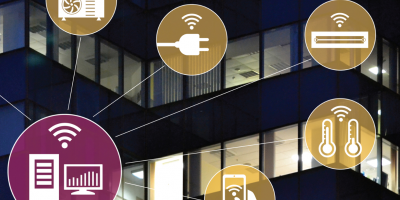Industry leader in integrated building energy management:
Making U of M buildings online for efficiency and safety
Until the COVID-19 pandemic, most people may not have given a second thought to how the heating, ventilation, and air conditioning (HVAC) systems in buildings functioned, unless — of course — it was too hot or too cold. The pandemic highlighted the need for safe, efficient ventilation indoors and, for a group in U Services, it also brought to light the management of those systems. At the same time, the U Services group was also finding ways to reduce energy costs and avoid disruptions to the U of M’s mission-driven work.
U Services’ Automation Group within Energy Management is already well known for taking complicated challenges and developing solutions that not only create efficiencies within the organization, but also for the industry as a whole. This group now manages more than 240 buildings throughout the Twin Cities, Duluth, and Morris campuses.
“From our research work with companies across the country, the U of M makes up the largest integrated control and monitoring system in North America — and possibly the largest integrated system in the world,” says Jeff Davis, assistant director for U Services Facilities Engineering and Utility Operations.
Building management
Each building is individually controlled by a building automation system (BAS), which manages the mechanical systems within a building to ensure a comfortable and safe environment. Additionally, University buildings are able to communicate with one another using the Building Automation Control Network (BACnet). The University’s Automation Group were early adopters of BACnet, which has become the industry standard building automation internet protocol. Adding a layer of technical complexity to that, the University manages an overarching energy management system (EMS) that collects and processes building alarms while maintaining optimal building conditions.
“The size and complexity of the U of M energy management system (EMS) has earned us a unique reputation in the industry,” says Dan Bellows, the controls engineering supervisor in U Services. “We are able to help set the standard for BACnet integrated control systems by working directly with manufacturers and development teams. We have become a technical liaison for large-scale facilities like military bases, skyscrapers, hospitals, and other higher education institutions.”
The goal for the Automation Group has been to simplify and update processes to tie all the buildings together and proactively identify potential mechanical problems.
“Our Automation Group consistently finds ways to be responsive to our campus buildings before any issues arise,” says Mike Berthelsen, U Services vice president. “By connecting the buildings together, we can detect when, or if, maintenance should be done, which not only saves the University time and money but reliably provides the necessary conditions for learning, clinical care, and research.”
More than two dozen manufacturers have, over the years, been used to install nearly 800,000 sensors and other set points across three U of M campuses. The challenge was to then tie those buildings together — allowing them to be online together and “talk” to one control system.
“We work closely with a variety of vendors in this industry to test and install enterprise solutions,” says Bellows. “We continue to play a role in the refinement and evolution of these protocols that allow building systems to communicate with each other, similar to other technology innovations. Currently, our team is working with vendors to develop and implement what is called “secure connect,” which adds a layer of security to critical ‘Internet of Things’ building control and monitoring systems that are connected to the internet.”
Detecting faults before they happen
Until recently, the University maintained a separate fault detection diagnostic (FDD) system that ran alongside, yet separately, from the EMS. Now, these functions are combined, providing sensor readings designed to identify patterns of irregularities so University energy technicians, mechanics, and engineers can quickly investigate and correct them.
“Faults that remain undetected can cause increased operating costs and unnecessary wear on mechanical equipment,” says Bellows. “Having automated FDD capabilities is especially important at the University, where, due to its sheer size, it is impossible to manually find all the control and mechanical faults.”
Game-changing upgrades
“Our team's ability, and practice, to work closely with vendors and manufacturers leads to discoveries and industry-leading advances to our systems, which then benefit every organization that uses these types of technology,” says Berthelsen.
Some of these future upgrades and enhancements include the ability to use diagnostic controls through smart phones, tablets, and computers, all to simplify and streamline processes while eliminating back-and-forth trips to a desktop computer to troubleshoot equipment. This capability is currently industry mainstream but successfully adopting it for use with previous generational EMS that did not include this capability is the real key to success. EMS installation at a site this large is sort of like painting the Golden Gate Bridge. Don't stop in the middle and start over again until you complete it end to end.
“We are showcasing our leadership in building energy management, not just for the midwest region, but across the nation,” Berthelsen says. “We’re able to make these leaps in efficiency and solutions through our close collaboration with the University’s own technology partners, mechanics, engineers, and more while building networks of vendors who come to our campuses to explore possibilities.”
